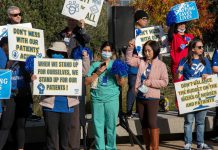A split city council decided to fund 100 percent of sidewalk
repairs provided it can later agree on how to fund the program.
GILROY
A split city council decided to fund 100 percent of sidewalk repairs provided it can later agree on how to fund the program.
With the mayor casting his “No” vote over the phone from Japan, the city council split in a symbolic 4-3 vote Monday night. Councilmembers decided, in principle, to pay all of the costs associated with repairing the city’s damaged sidewalks, but the decision depends on the council agreeing on a financing plan. How long that will take city staff is not known at this point.
Before the vote, Mayor Al Pinheiro’s digitally choppy voice echoed through the council chambers, dropping in and out from sister city Takko-Machi, Japan, where he was representing Gilroy.
“Please, let’s take it easy. Let’s not put our future at risk,” said Pinheiro, an insurance salesman.
He cited shaky economic times and the city’s $3.9 million deficit as reasons to be prudent. For these reasons, he and Councilmen Dion Bracco and Peter Arellano rejected the idea of taking millions from Gilroy’s reserve fund, which has fallen to about $16 million from more than $26 million a year ago.
Bracco has also stressed that the city needs a plan before it “throws money away” that could otherwise eventually hire more police officers to address Gilroy’s growing gang problem.
“We just had another gang shooting today,” Bracco said. “I’m scared to spend our reserves at this time because of the state of our economy.”
Bracco also said he was once “naive” enough to think campaign promises meant everything, “But when you get up here, you find out there’s a whole lot more to running the city than the sidewalks.”
“But it’s not just a promise I made. It’s one of the reasons I ran to be on this council,” Woodward said. “There’s always going to be some reason not to do it.”
In a separate, subsequent vote, the council voted 5-2 to direct staff to come up with $2 million to begin fixing the sidewalk problem, whether that money comes from delaying future projects, the reserve fund or the city’s stressed general fund. Arellano and Pinheiro voted against the direction.
Staff told the council two weeks ago there’s nothing left to scrape after the $13 million purchase earlier this year of 536 acres of land that includes Gilroy Gardens, but the body directed its financial team to look again ahead of another sidewalk study session to occur in the next few weeks, according to City Administrator Tom Haglund.
Another contentious policy the council will discuss at the next study session – and something Bracco has said is necessary to come up with before the city spends any money – is the city’s street tree policy. Until recently, the policy required city trees with concrete-cracking roots to be planted between the curb and sidewalk. However, the city still has not prepared a replacement policy, which is expected in mid-October, according to a statement Community Services Director Susan Andrade-Wax made to the council two weeks ago.
As far as generating the new numbers and identifying intra-city loan sources, Gartman said it simply amounts to borrowing $2 million against the $19 million Gilroy has dedicated to roll-over funds and future projects. The city found $13 million for Gilroy Gardens, he said, so it can certainly find money for sidewalk repair.
Until the city finds this money and agrees on a time frame to fix every inch of broken sidewalk – which could take anywhere from 18 months to two years, according to council members who said they spoke with contractors – the city’s nascent 80-20 program will continue. Dozens of property owners have taken advantage of the program, by which residents evenly split the cost of sidewalk repair with the city but pay nothing for new curbs, gutters, asphalt or tree removal. In the end, they end up footing about 20 percent of the total repair cost.
That program will continue until the council identifies a new funding mechanism to cover 100 percent of residents sidewalk repair costs. There will be no reimbursements for property owners who have already fixed their own sidewalks.
Though, in the meantime, residents within a Texas-shaped area in west Gilroy bound by Wren Avenue, Uvas Park Drive, Ponderosa Drive, Monte Bello Drive and Cypress Court will have their sidewalks – which staff deemed the worst in the city – fixed with the city paying the full cost, as it will eventually do for the whole city.
Still, Arellano and Pinheiro have celebrated the popularity of the 80-20 program, which replaced the 50-50 program that a community-based sidewalk task force endorsed in 2006. Two weeks ago, Gartman and Woodward voted against a motion to hold Monday night’s study session if it meant continuing the 80-20 plan. Councilwoman Cat Tucker clarified Monday that she voted to continue the program while the council figures out if paying 100 percent is feasible, in part because there are more than 70 people on the existing waiting list, she said.
When it comes to the finances of sidewalk repair, some of the 67 residents who have participated in the 80-20 program hired their own contractors and then billed the city for its 80-percent portion while others had the city do all the work and then sent in a check for about 20 percent. When the city does the legwork, it adds costs to bid the project, clear out the physical area, set up traffic controls and inspect the work, according to City Engineer Rick Smelser. A resident can get things cheaper, though, by avoiding overhead costs and government wage requirements that the city must abide by when it sends large projects out to bid. The cost discrepancy has been a point of concern among the council.
The $11 million projection represents how much repairing all the sidewalks will cost if the city hires contractors, versus the $7 million if residents hire the labor.
The last estimate pegged the total bill at about $7.9 million, and this summer’s sidewalk survey – during which staff painted concrete rifts orange all over Gilroy – shows that the city likely has millions more in costs and more than 14 years of repairs at the current pace.













